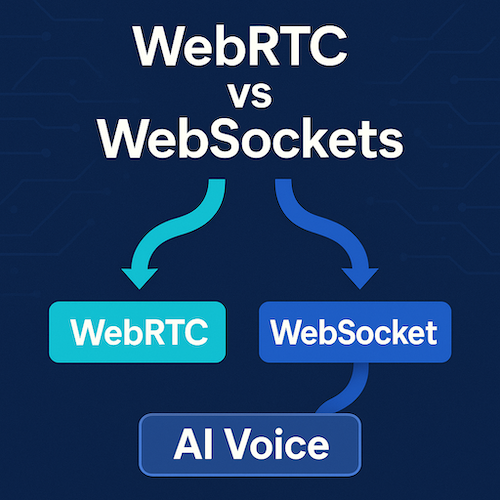WebRTC vs WebSockets for AI Voice: Why Gabber Offers Both

When you're building with AI voice, choosing the right real-time protocol matters — a lot.
Two major players dominate:
- WebRTC: Designed for real-time peer-to-peer media.
- WebSockets: Built for real-time messaging and data streams.
At Gabber, we support both — because different apps need different approaches:
- Our real-time AI conversation engine runs on WebRTC.
- Our TTS-only plug-in API uses WebSockets for easy integration.
Here’s how it breaks down — and how to pick the right tool for your AI app.
Quick Comparison: WebRTC vs WebSockets
| Feature | WebRTC | WebSockets |
|---|---|---|
| Protocol | UDP (peer-to-peer) | TCP (client-server) |
| Setup Complexity | High (STUN/TURN servers) | Low (single server connection) |
| Ideal For | Live voice conversations | Streaming TTS audio |
| Latency | Extremely low | Low |
| Media Handling | Built-in voice/video optimization | You manage media streams manually |
Why Gabber Uses WebRTC for Full Real-Time AI Conversations
When you’re building a dynamic voice-first AI, you need:
- 📞 Two-way voice communication
- ⚡ Instant interruption support (mid-sentence)
- 🔄 Live tool-calling, memory updates, and persona switching
- 🎙️ Extremely low jitter, low latency media exchange
WebRTC was designed for this.
It optimizes voice streams using:
- UDP transmission (faster packet delivery)
- Adaptive bitrate adjustments
- Echo cancellation and NAT traversal
That’s why Gabber’s core real-time engine — powering AI companions, voice coaching, phone AI bots, and more — is built on WebRTC.
Why Gabber Offers WebSocket TTS for Plug-and-Play Simplicity
Sometimes you don’t need full conversation handling — you just want affordable, high-quality TTS.
If you already have:
- 🛠️ A WebSocket-driven app
- 🎮 A game that streams data over WebSockets
- 📱 A mobile app with a persistent WebSocket layer
…then switching to WebRTC just for voice doesn't make sense.
That’s why Gabber’s TTS-only API is available over WebSockets:
- 🔌 Simple integration (no STUN/TURN config)
- 📡 Stream synthesized voice in real time
- 🧩 Drop-in compatibility with WebSocket-based apps
You get all the benefits of Gabber's high-quality voices (like Orphoeus and Cartesia models) without restructuring your app’s network stack.
Which Should You Use?
Choose WebRTC if:
- You want interactive, live AI conversations
- You need interruptable speech and dynamic flow control
- You’re building full apps, companions, bots, or coaching tools
Choose WebSocket TTS if:
- You want to embed AI speech into an existing WebSocket-based app
- You only need one-way audio (TTS output)
- You prioritize simplicity over conversation complexity
Gabber Gives You Both
Unlike most platforms that force you into one protocol, Gabber adapts to your build:
- 🎙️ Full conversational AI over WebRTC (voice + tool calling + memory)
- 🗣️ Simple TTS output over WebSockets (voice only)
Same quality. Same speed. Different flexibility — based on your app’s needs.
TL;DR: One Stack, Two Paths
In 2025 and beyond, great AI apps will be:
- Real-time
- Voice-powered
- Latency-optimized
Gabber gives you the flexibility to build it your way — whether you need full conversational pipelines or lightweight speech streaming.
🚀 Ready to build? Try Gabber's AI Voice Platform